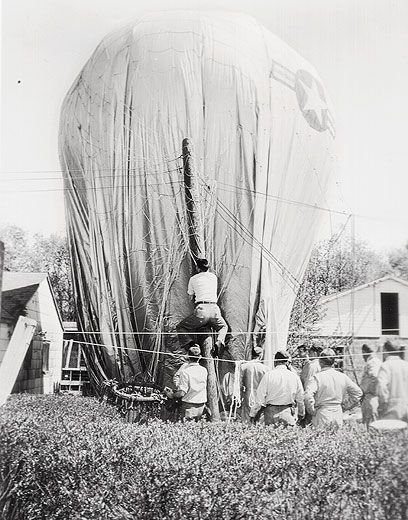Oldies and Oddities: Buying the Farmhouse
Adventures in Navy ballooning.
/https://tf-cmsv2-smithsonianmag-media.s3.amazonaws.com/filer/FM-2011-oldies-and-oddities-FLASH.jpg)
Since the early 1920s, the U.S. Navy included balloons in its training program for lighter-than-air, which ended in 1961. Balloons offered a superb course in applied aerology. Students learned quickly that the atmosphere is remarkably complex and variable. Ballooning is demanding, but it is also great sport.
My last balloon flight occurred in May 1961 at Naval Air Station Lakehurst, New Jersey, following an Armed Forces Day celebration. One of our 35,000-cubic-foot balloons had been inflated to give rides to kids—up and down—in the main hangar. Following the festivities, it was left tethered inside. At the end of June, I would be retiring from the naval service, so I decided to exercise my prerogative as station commanding officer.
I assigned a young lieutenant as copilot. The commanding officers from two tenant commands and a professor of aeronautics from Princeton University completed the roster.
We assembled at Hangar One, where the aircraft was being restrained by station personnel. We scrambled in, and sandbag ballast was offloaded until the ship was in equilibrium—its weight literally zero. At 10:50 the “Let go!” order was given.
Pouring out sand, we floated skyward. As the ship drifted north, we began a rapid rate of climb to about 1,500 feet, checking our ascent with a couple of pulls on the valve cord.
After several pleasant minutes I decided it would be fun to drop down. I would ease out the drag rope—automatic ballast used to orient the “bag” for landing—and skim the treetops.
I called for my copilot to pull the valve rope for five or six seconds. When he turned it loose, we didn’t hear that satisfying flap indicating that the valve had closed again. The rope hung limp. We started dropping—really dropping.
It was obvious that the valve was still wide open. Several anxious tugs confirmed there was nothing we could do. The ship was losing helium fast. I started pouring sand from an open bag, but that didn’t slow us. We dropped the whole bag, then started dropping bag after bag.
As we plunged, I ordered everyone to grab onto the load ring just above our heads, to which the balloon (from above) and the basket (from below) were attached. I didn’t know how hard we would hit; bracing on the ropes would cushion the impact.
The basket crashed through the trees, but the balloon caught on the canopy, with us dangling below. A big tree caught the basket’s corner, however, twisting it around. One officer lost his grip and spilled over the side. Abruptly freed of 200 pounds, the balloon sprang skyward. The impact had nearly tossed a captain overboard as well; he was now hanging on outside the basket. As we bounded aloft I grabbed him by the seat of the pants and pulled him inside. Safe, for the moment.
All this time, gas was escaping from the valve. (We later discovered that the “wishbone” on the butterfly valve, the device that pulled the valve closed, had broken.) We reached the apex of our rise. Down we started, again.
We were dropping sandbags as fast as we could get them over the side. We returned to earth a quarter of a mile farther on. Our unintended target this time was a small farmhouse.
We hit the TV antenna, knocking it off the house, then were nearly impaled on a telephone pole. The balloon crashed down, the basket hanging from the phone wires six feet off the ground. I pulled the ripcord, deflating the ship onto the pole and wires. The only flight casualty: abrasions to our missing passenger, whom we met when we backtracked to our first point of touchdown to retrieve our hats.
